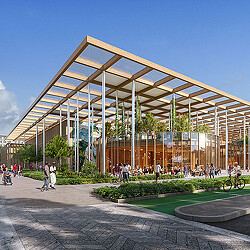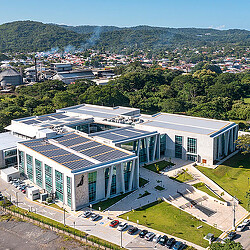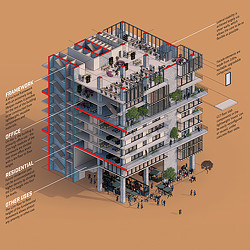How to Design for Resilience
Resilient design is no longer a nice-to-have; it’s a smart business decision and a critical response to increasingly severe weather and climate events.

Resilience has become an essential lens through which we design the built environment. As the world continues to experience more severe weather events, which in turn present a significant financial risk to real estate assets, we must prepare our buildings to withstand these events. This requires designs that are tough, as well as flexible, while providing the ability to not only bounce back, but forward.
The American Institute of Architects (AIA) defines resilience as “the ability of a system and its component parts to anticipate, absorb, accommodate, or recover from the effects of a hazardous event in a timely and efficient manner, including through ensuring the preservation, restoration, or improvement of its essential basic structures and functions.”
Real estate assets that have adopted resilient design strategies are now trading at higher values than those without them. Resilient design is no longer a nice-to-have; it’s good business.
This is why we publish an annual, in-depth look at our entire design portfolio through the lens of energy use and carbon emissions. By sharing effective design strategies and openly tracking our progress toward carbon reduction goals, we can help our clients reach their business goals.

We estimate that Gensler’s 2024 design portfolio will avoid emitting 19.6 billion kilograms of CO₂e — a 64% reduction in operational carbon emissions compared to the baseline. This number results from design actions reducing energy demand across thousands of projects.

We also study the impact of our own offices. In fiscal year 2024, Gensler’s office operations emitted 40.75 million kilograms of CO₂e across 56 offices. Today, 23 of our offices are LEED certified, 10 utilize renewable energy, and 29 have a composting program.
Our goal is to reach zero emissions by 2030 for all our projects, so we continue to seek out innovative materials and design solutions.
Projects like C-PARK Haisu in Shanghai, China, use innovative façade design to slash operational energy use and carbon emissions. Other projects are delivering energy and carbon reduction strategies, like our own office in San Francisco, which is already operating at carbon zero by using all-electric utilities, 51% reused furniture and equipment, and implementing a zero-waste strategy.

We’re also looking ahead and exploring how we can push the envelope for the future. A team in the firm is exploring opportunities to harvest the heat generated by data center operations to heat residential neighborhoods and grow carbon-sequestering algae. By cultivating algae in panels built around the building façade, a single data center can capture between 14,000-25,000 kg of CO2 from the atmosphere.
Another research project called The 600-Year Office is looking at how we can design offices for long-term use by eliminating obsolescence from the built environment even while facing a rapidly changing climate.

In a community-led example of design resilience, the Englewood Agro-Eco District will repurpose a 1.75-mile track of an abandoned railroad to create a natural recreation trail that will act as a catalyst for revitalization for the nation’s first Agro-Eco district, where Englewood will serve as an economic center for urban agriculture for indoor and outdoor farming.

Resilient design is a smart business decision and a critical response to increasingly severe weather. The most impactful strategies begin early in the design phase in order to align client goals with environmental priorities and community needs. This upfront collaboration leads to high-performing, cost-effective solutions that deliver long-term value.
By shifting the focus from initial costs to lifecycle benefits, we help clients reduce risk, save on operations, and meet their carbon goals. Resilient design isn’t only about recovery. It’s about designing spaces that are prepared for the future and built to last.

For media inquiries, email .







